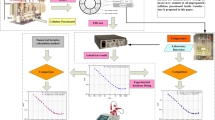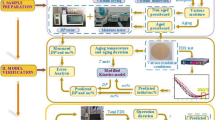Abstract
The moisture evaluation of cellulose insulation material in paper/oil system based on the frequency dielectric spectroscopy (FDS) technique has been of great interest to researchers. However, the electrode polarization effect and conductance effect can “obscure” the relaxation information in the course of the traditional FDS test, which often leads to an unreliable result. The existing researches indicated that the frequency dielectric modulus-M*(ω) could effectively enable the investigation of the relaxation behavior, which might be used to realize the condition evaluation of cellulose insulation materials in paper/oil system. Unfortunately, the M*(ω) has been rarely exploited to evaluate the moisture content (mc%) of cellulose insulation material, and the study on approach for extracting characteristic parameters based on the M*(ω) is also rare. In view of this issue, the present contribution attempt to report an available approach for extracting the characteristic parameters based on the M*(ω), and further investigate the variation laws of mc% versus the above parameters. The findings reveal that the quantitative relationship between mc% and the above parameters can be established by fitting analysis. The feasibility of the proposed parameters for moisture evaluation of cellulose insulation material is demonstrated by the newly prepared cellulose insulation samples. It is interesting to note that the average percentage errors of evaluation results corresponding to the relaxation time constant (τM) and integral value (IV) of the real part of M*(ω) are less than 8%. In that respect, the novelty of this work is that the τM and IV might be used as a potential tool for quantitative evaluation of mc% of cellulose insulation in paper/oil systems.
Graphic abstract













Similar content being viewed by others
References
Bagheri M, Phung BT, Blackburn T (2014) Influence of temperature and moisture content on frequency response analysis of transformer winding. IEEE Trans Dielectr Electr Insul 21(3):1393–1404
Cole KS, Cole RH (1941) Dispersion and absorption in dielectrics-I: alternating current characteristics. J Chem Phys 9(4):341
Cole KS, Cole RH (1942) Dispersion and absorption in dielectrics-II: direct current characteristics. J Chem Phys 10(2):98
Ding HZ, Wang ZD (2008) On the degradation evolution equations of cellulose. Cellulose 15(2):205–224
Emsley AM (1994) Kinetics and mechanisms of the low-temperature degradation of cellulose. Cellulose 1:26–56
Emsley AM (1997) On the kinetics of degradation of cellulose. Cellulose 4:1–5
Emsley AM, Xiao X, Heywood R (2000) Degradation of cellulosic insulation in power transformers. Part 2: formation of furan products in insulating oil. IEE Proc Sci Meas Technol 147:110–114
Feng DW, Yang LJ, Liao RJ, Zhou LW (2018) Effect of moisture content on the production and partitioning of furfural in oil-paper. IEEE Trans Dielectr Electr Insul 25(6):2389–2397
Haque N, Dalai S, Chatterjee B, Chakravorti S (2019) Studies on the effects of moisture and ageing on charge de-trapping properties of oil-impregnated pressboard based on IRC measurement. High Volt 4(2):151–157
Hodge IM, Ingram MD, West AR (1976) Impedance and modulus spectroscopy of polycrystalline solid electrolytes. J Electroanal Chem 74:125–143
Hu YZ, Dong M, Xie JC, Xu GG, Ren M (2018) Dielectric modulus: effective and novel tool in insulation assessment of oil-impregnated paper. In: Proceedings of ICITEE ‘18. Xiamen, Fujian
Jadav RB, Ekanayake C, Saha TK (2014) Understanding the impact of moisture and ageing of transformer insulation on frequency domain spectroscopy. IEEE Trans Dielectr Electr Insul 21(1):369–379
Jinscher AK (1999) Dielectric relaxation in solids. J Phys D Appl Phys 32(14):57–70
Kao KC (2004) Dielectric phenomena in solids. Academic Press, Cambridge, p 446449
Li J, Zhang ZT, Grzybowski S, Liu Y (2012) Characteristics of moisture diffusion in vegetable oil-paper insulation. IEEE Trans Dielectr Electr Insul 19(5):1650–1656
Liao RJ, Liu JF, Yang LJ et al (2015a) Quantitative analysis of insulation condition of oil-paper insulation based on frequency domain spectroscopy. IEEE Trans Dielectr Electr Insul 22(1):322–334
Liao RJ, Liu JF, Yang LJ et al (2015b) Understanding and analysis on frequency dielectric parameter for quantitative diagnosis of moisture content in paper–oil insulation system. IET Electr Power Appl 9(3):213–222
Liu JF, Zheng HB, Zhang YY et al (2017) Grey relational analysis for insulation condition assessment of power transformers based upon conventional dielectric response measurement. Energies 10(10):1526
Liu JF, Fan XH, Zheng HB, Zhang YY et al (2019a) Aging condition assessment of transformer oil-immersed cellulosic insulation based upon the average activation energy method. Cellulose 26(6):3891–3908
Liu JF, Fan XH, Zhang YY, Zheng HB et al (2019b) Condition prediction for oil-immersed cellulose insulation in field transformer using fitting fingerprint database. IEEE Trans Dielectr Electr Insul. https://doi.org/10.1109/TDEI.2019.008442
Macedo PB, Moynihan CT, Bose R (1972) The role of ionic diffusion in polarization in vitreous ionic conductors. Phys Chem Glasses 13:171–179
McCrum NG, Read BE, Williams G (1967) Anelastic and dielectric effects in polymeric solids. Wiley, NewYork, pp 108–111
Ojha SK, Purkait P, Chatterjee B, Chakravorti S (2019) Application of Cole–Cole model to transformer oil-paper insulation considering distributed dielectric relaxation. High Volt 4(1):72–79
Oommen TV (1983) Moisture equilibrium in paper-oil insulation systems. In: IEEE electrical/electronical insulation conference, Chicago, pp 162–166
Oommen TV, Prevost TA (2006) Cellulose insulation in oil-filled power transformers: part II maintaining insulation integrity and life. IEEE Electr Insul Mag 22(2):5–14
Tian FQ, Ohki Y (2014) Electric modulus powerful tool for analyzing dielectric behavior. IEEE Trans Dielectr Electr Insul 2(3):929–931
Wang DY, Zhou LJ, Wang LJ, Guo LW (2019) Modified expression of moisture diffusion factor for non-oil-immersed insulation paper. IEEE Access 7:41315–41323
Yang LJ, Chen JR, Wang SH et al (2018) Dielectric response measurement of oil-paper insulation based on system identification and its time-frequency-domain conversion method. IEEE Trans Dielectr Electr Insul 25(5):1688–1698
Yang LJ, Zou TT, Deng BF, Zheng HB, Mo Y, Peng P (2019) Assessment of oil-paper insulation aging using frequency domain spectroscopy and moisture equilibrium curves. IEEE Access 7:45670–45678
Zaengl WS (2003) Dielectric spectroscopy in time and frequency domain for HV power equipment. I. Theoretical considerations. IEEE Electr Insul Mag 19(5):5–19
Zhang M, Liu J, Lv J, Chen Q, Qi P, Sun Y, Jia H, Chen X (2018a) Improved method for measuring moisture content of mineral-oil-impregnated cellulose pressboard based on dielectric response. Cellulose 25:5611–5622
Zhang DN, Yun H, Zhan JY et al (2018b) Insulation condition diagnosis of oil-immersed paper insulation based on non-linear frequency-domain dielectric response. IEEE Trans Dielectr Electr Insul 25:1980–1988
Żukowski P, Kołtunowicz TN, Kierczyński K et al (2016a) Dielectric losses in the composite cellulose–mineral oil–water nanoparticles: theoretical assumptions. Cellulose 23:1609–1616
Żukowski P, Kołtunowicz TN, Kierczyński K et al (2016b) Permittivity of a composite of cellulose, mineral oil, and water nanoparticles: theoretical assumptions. Cellulose 23:175–183
Acknowledgments
This work was supported in part by the National Natural Science Foundation of China (61473272; 51867003; 51907034), and in part by the Natural Science Foundation of Guangxi (2018JJB160056; 2018JJB160064; 2018JJA160176), and in part by the Guangxi Bagui Young Scholars Special Funding, and in part by the Boshike Award Scheme for Young Innovative Talents, and in part by the Basic Ability Improvement Project for Young and Middle-aged Teachers in Universities of Guangxi (20190067; 20190046).
Author information
Authors and Affiliations
Corresponding author
Additional information
Publisher's Note
Springer Nature remains neutral with regard to jurisdictional claims in published maps and institutional affiliations.
Rights and permissions
About this article
Cite this article
Liu, J., Fan, X., Zhang, Y. et al. Quantitative evaluation for moisture content of cellulose insulation material in paper/oil system based on frequency dielectric modulus technique. Cellulose 27, 2343–2356 (2020). https://doi.org/10.1007/s10570-019-02820-3
Received:
Accepted:
Published:
Issue Date:
DOI: https://doi.org/10.1007/s10570-019-02820-3




